Exploring the Elegance of Emerald Cuts in Jewelry
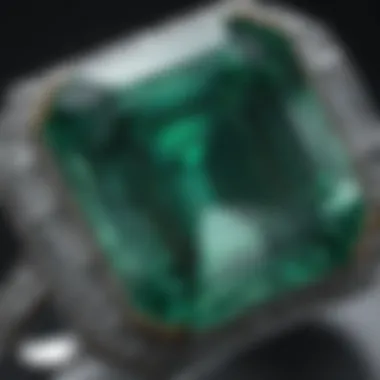

Intro
Emerald cuts are not just a style of gemstone cutting; they represent a bridge between art and craftsmanship, meticulous design paired with a rich history. This article will take you on a journey through the intricacies of emerald cuts, encompassing their historical roots, distinct attributes, and the delicate processes that bring them to life. Furthermore, we'll delve into valuable insights for selecting emerald cut gemstones—informing both enthusiasts and those who might just be dipping their toes into the vast sea of gemstones.
Gemstone Overview
Definition of Gemstones
At the most fundamental level, gemstones are precious or semi-precious minerals, rocks, or organic materials that are cut and polished to create beautiful pieces of jewelry. They are celebrated not only for their aesthetic qualities but also for their intrinsic value, captivating the minds and hearts of gem collectors and jewelry designers alike. Each gemstone carries its own story, a narrative woven through time.
Classification of Gemstones
Gemstones are classified into categories based on various characteristics:
- Precious Gemstones: These include diamonds, rubies, sapphires, and emeralds, known for their rarity and quality.
- Semi-Precious Gemstones: This group contains a broader range of gems, such as amethyst, aquamarine, and garnet, often more accessible in terms of pricing.
- Organic Gemstones: Considered gems, even though they originate from living organisms. Examples include pearls and amber.
Understanding this classification provides the groundwork necessary to appreciate the unique position emerald cuts hold in the gemstone realm.
Historical Significance
Origins of Gemstone Use
The use of gemstones dates back thousands of years, often intertwined with notions of wealth, status, and spirituality. In ancient cultures, gemstones were believed to possess mystical properties or healing powers. Emeralds, particularly, have held a place of prestige. Cleopatra, known for her beauty, famously favored emeralds, reflecting their allure and significance during her reign.
Cultural Insights: Gemstones in Ancient Civilizations
Throughout history, gemstones like emeralds have found their way into various civilizations:
- The Egyptians revered emeralds, associating them with fertility and rebirth.
- In Ancient Rome, they were symbols of luxury and were often used in jewelry indicating one's social status.
- The Aztecs regarded these gemstones as sacred, linking them to their gods.
Emeralds have not only graced royal crowns but also served as tokens of love and commitment, cementing their importance in human relationships.
As we explore further down the narrative path of emerald cuts, we dive into the architectural allure and unique processes involved in their creation, offering those interested a well-rounded foundation on which to build their understanding of these exquisite gems.
The Historical Context of Emerald Cuts
Emerald cuts have a rich heritage that transcends time, merging artistry with skill in jewelry making. To understand the significance of emerald cuts, one must delve into their origins and the cultural narratives that surround them. This section paints a comprehensive picture of their historical journey, illustrating how these cuts evolved in beauty and meaning, much like the gemstones themselves.
Origins and Evolution
Emerald cuts date back to the 15th century when they were initially crafted for emeralds, a popular gemstone during the Renaissance. Their distinct rectangular shape with cropped corners was designed to show off the gem’s deep color while minimizing the appearance of inclusions. This cutting style invites comparisons to architectural forms, reminiscent of grand windows in Gothic cathedrals.
Over the centuries, the emerald cut transitioned from being primarily associated with emeralds to becoming a favored style for diamonds and other gemstones. As techniques advanced, the emerald cut adapted, showcasing a broader spectrum of colors, from white sapphires to rubies. The evolution of this cut signifies not only innovation in gem cutting but also changing aesthetic preferences through the ages.
Cultural Significance Throughout History
Emerald cuts hold a certain allure across various cultures. In ancient Egypt, emeralds were seen as symbols of fertility and rebirth, often associated with the goddess Isis. The emerald cut allowed these stones to shine, becoming an integral part of Egyptian jewelry, adorning nobility and the wealthy.
“In every culture, gemstones carry stories, and the emerald cut is no different.” As the centuries progressed, the emerald cut found its place in European royalty as well, often featured in crowns, scepters, and various royal regalia. This continued connection with power and elegance further solidified the emerald cut's significance in cultural contexts.
Emerald Cuts in the Royal Jewelry Collection
Royal collections have showcased emerald cuts, proving their status as symbols of sophistication. For instance, Queen Elizabeth II has adorned her collection with emerald-cut diamonds, signifying both beauty and opulence. Such pieces often represent notable milestones in history, weaving tales from one generation to the next.
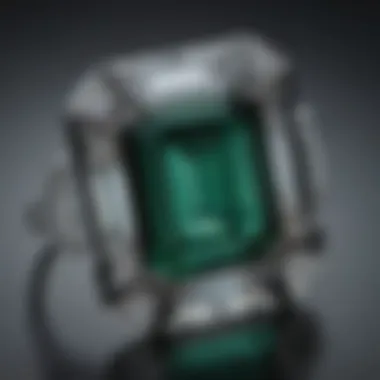
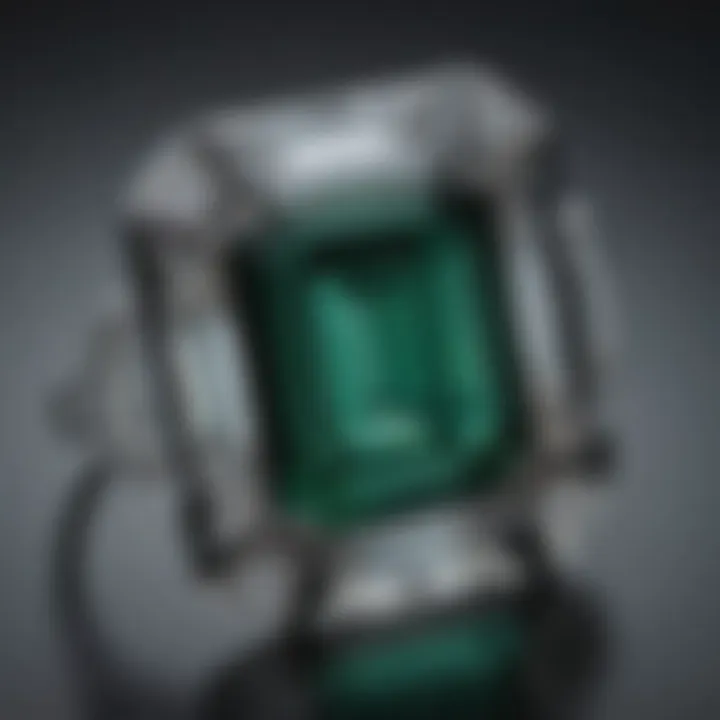
Furthermore, during the Victorian era, remaining fashions led to the incorporation of emerald cuts into everyday wear, transforming extravagant royal adornments into pieces accessible to the upper classes. This democratization of style, reflecting the changing values of society, expanded the emerald cut's allure beyond royal boundaries.
In summary, understanding the historical context of emerald cuts reveals a journey filled with symbolism, artistry, and cultural resonance. From ancient Egypt to modern-day royalty, these cuts continue to captivate gemstone enthusiasts, collectors, jewelry designers, and geology enthusiasts alike.
Understanding the Emerald Cut
The emerald cut is renowned for its elegance and sophistication, standing apart in the realm of gemstone cuts. Recognizing its unique attributes is essential not just for connoisseurs but also for those venturing into the world of gemstones for the first time. The emerald cut has a distinctive rectangular or square shape with cropped corners, which sets it apart from many other cuts. This design allows for a larger surface area than many round cuts, showcasing the stone's color and clarity effectively.
One significant benefit of understanding the emerald cut lies in its ability to highlight the gem's qualities. Gems cut in this style exhibit fewer facets than intricate shapes, such as the brilliant cut. Still, they possess a remarkable ability to reflect light, presenting an allure that captivates the eye. For collectors, selecting an emerald cut can open doors to vibrant interactions between light and color, particularly with high-quality stones.
Moreover, this understanding guides consumers in making informed decisions when purchasing emerald cut gemstones. Recognizing the complexities involved in selecting these stones leads to a more gratifying experience. The facets can influence not just the appearance but also the value of the gemstone, making awareness of these factors pivotal in the jewelry-buying journey.
Defining Characteristics of Emerald Cuts
Emerald cuts are characterized by their step-cut facets which create a hall of mirrors effect that allows for a unique perception of depth. This ideal showcases the color of the gem rather than solely focusing on brilliance. While traditional brilliant cuts aim to maximize sparkle, the emerald cut flirts with a more subdued elegance. Important traits to observe include:
- Rectangular Shape: The standard emerald cut features a rectangular shape; however, a square version is not uncommon, often labeled as a square emerald cut.
- Facets: Typically, there are eight main facets and a broad table, which gives it a less fiery but more sophisticated appearance.
- Larger Table Surface: The larger flat surface provides an unobstructed view of the gemstone’s natural beauty.
Comparing Emerald Cuts to Other Shapes
In the world of gemstones, the emerald cut’s simplicity can often be juxtaposed with other, more complex cuts. While cuts like the round brilliant are designed to maximize dispersion and sparkle, emerald cuts take a different route, honing in on the clarity and color of the stone itself.
When comparing to the brilliant cut:
- Brilliance vs. Clarity: Brilliant cuts focus on sparkle via numerous small facets, letting the light create a dazzling effect. In contrast, emerald cuts leave most of the gem’s area exposed, allowing light to move through rather than bouncing off at various angles.
- Stone Size Appearance: Emerald cuts can make a stone appear larger due to their surface area, which can be particularly appealing in rings or pendants.
- Visual Style: The aesthetic vibe of an emerald cut leans toward vintage elegance, often appreciated in heirloom pieces, while brilliant cuts may be seen in modern, flashy designs.
Influence of Shape on Light Performance
An emerald cut’s shape plays a critical role in how it interacts with light. With fewer facets, the light performance relies heavily on how the Emerald Cut’s geometry affects the reflection and absorption of light. As light enters through the cut, it travels deeper into the gem, interacting with the crystalline structure. Here are some noteworthy influences:
- Transparency: Emerald cuts can project transparency and visual depth. These features highlight the stone’s natural clarity and any internal characteristics like inclusions.
- Color Saturation: The open design enhances the vivid hues, allowing observers to appreciate the rich colors without interference from excess reflections found in cuts with more facets.
- Light Patterns: The steps create alluring light patterns with ribbons of reflection, setting the emerald cut apart from its more brilliant cousins.
"Emerald cuts exude a kind of sophistication that reminds one of understated luxury, making it a timeless choice for those who appreciate both artistry and fine detail."
Understanding these intricacies can lead individuals to appreciate or select emerald cuts with a more discerning eye, which ultimately elevates the value of the pieces they choose. By grasping the essential traits of emerald cuts, enthusiasts can navigate their gemstone journey with astuteness and intention.
The Craftsmanship Behind Emerald Cuts
The artistry involved in creating emerald cuts is a pivotal aspect when it comes to understanding the overall allure of these gemstones. This craftsmanship combines technical precision and an artistic vision that transforms raw material into a striking piece of jewelry. Each emerald cut, with its defined angles and steps, has its story and individuality woven into the fabric of its creation. This section delves into the intricate processes that bring emerald cuts to life, showcasing not only the skills of the artisans but also the significance of each step in achieving the final result.
The Cutting Process Explained
Cutting an emerald is no simple feat. Unlike more common shapes such as round or oval, the process of creating an emerald cut demands attention to detail and a deep understanding of the stone’s properties. The cutting process typically begins with the selection of a suitable raw gemstone, which often comes with its own set of flaws and inclusions, commonly referred to as its 'garden'. This initial choice sets the stage for how the cut will reveal the gem's internal beauty.
After selection, the stone is precisely cleaved or sawn, using specialized blades, which allow the cutter to extract the most appealing diamond parameters from the rough. The gemstone is then shaped by first grinding and then polishing each facet to achieve the signature step-cut look the emerald is known for. Each facet must be angulated correctly to maximize light reflection, thereby enhancing the stone's brilliance while preserving its clarity.
Tools and Techniques Used in Emerald Cutting
Emerald cutting requires a suite of specialized tools designed for the unique demands of this craft. Some of the most important tools include:
- Diamond Blades: Used for the precise cutting of the raw stone. These blades are critical for making accurate incisions without damaging the gem.
- Protractors: Essential for measuring the angles that will ultimately define the cut.
- Polishing Wheels: After the shapes have been cut, polishing wheels help smooth out the facets, allowing the emerald to shine brightly.
- Magnifying Lenses: Used to evaluate the gem during each stage, ensuring precision and quality throughout the cutting process.
Modern techniques also incorporate technology such as computer-aided designs (CAD), providing gem cutters with advanced tools to visualize the finished product before ever making a cut. This marriage of traditional craftsmanship with modern technology symbolizes the evolution of emerald cutting.
Importance of Precision in Emerald Cutting
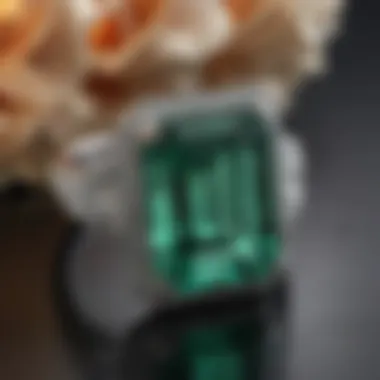
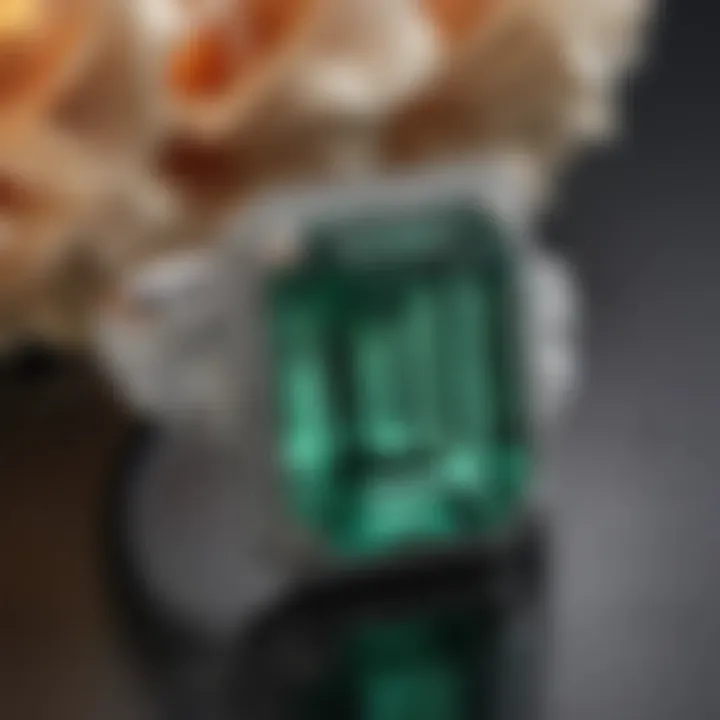
Precision in emerald cutting cannot be overstated. As each facet of the emerald is intricately intertwined with light performance, even the slighest miscalculation can lead to diminished beauty and clarity.
Emeralds often contain inclusions, so it’s crucial that a cutter understands how to best position these imperfections, working them into the cut rather than against it. Each facet's alignment directly influences how light reflects through the stone, playing a pivotal role in its overall aesthetic appeal. Properly executed cuts can lead to dramatic flashes of light that dance across its surface, which are particularly sought after in high-end jewelry.
In summary, the craftsmanship behind emerald cuts embodies a blend of time-honored techniques and modern innovations. Each stage in the cutting process requires intense concentration, with the cutter's skill directly correlating to the end product's quality. As gemstone enthusiasts and collectors, understanding these elements enriches the appreciation of emerald cuts, showcasing how more than mere shapes, they are the result of dedication, precision, and artistry.
Selecting Emerald Cut Gemstones
Selecting an emerald cut gemstone is an endeavor that requires careful thought and knowledge. It’s not simply about choosing a pretty piece; it’s about understanding the nuances of what makes an emerald cut distinct. With its unique rectangular facets and subtle elegance, an emerald cut isn't just a trend, but a timeless choice for those who appreciate fine jewelry. Knowing what to look for can enhance both beauty and value in your selection.
Factors to Consider When Choosing
When hunting for the perfect emerald cut gemstone, several factors come into play:
- Size and Shape: The size of the stone can drastically affect its presence. A large emerald cut can make a bold statement, while a smaller piece may be more understated and delicate. It's essential to balance size with the wearer's personal style.
- Color Quality: Emerald cuts are often associated with vibrant greens, especially in emeralds, but they can also be stunning in diamonds or other gemstones. Look for a rich color without too many inclusions, which can detract from the stone's overall appearance.
- Clarity: In emerald cuts, clarity is paramount. These stones flaunt their imperfections, and a clear emerald cut will showcase its artistry and shine. Inclusions are visible, so a higher grade is usually preferred, or else it can spoil the look.
- Cut Quality: The very quality of the cut determines how light interacts with the stone. An expertly cut emerald can reflect and refract light beautifully, giving it that sought-after sparkle. An inferior cut may appear dull and lifeless.
Evaluating Quality: Clarity, Color, and Cut
When evaluating emerald cut gemstones, three primary characteristics should be at the forefront of your assessment:
- Clarity: This is the measure of imperfections within and on the surface of a gemstone. For emerald cuts, higher clarity leads to better visual impact. It’s helpful to use a jeweler’s loupe to inspect the stone more closely.
- Color: The color of the gemstone impacts both its desirability and value. Look for deep, even color saturation across the entire surface of the stone. A well-colored emerald cut should ideally be free from dark patches or color zoning.
- Cut: While emerald cuts are known for their step-cut style, which makes it easier to see clarity, the precision of the cut is what brings out its beauty. This style does not have as much sparkle as other cuts, but it delivers a unique allure. Ideally, the cut should exhibit symmetry and proportionality.
The Role of Certification in Purchasing
Certification serves as the velvet rope between you and the world of gemstones; it ensures that what you're purchasing meets specific standards of quality. Having a gemstone certified generally means it has been inspected and graded by a reputable gemological laboratory.
Key points about certification include:
- Trustworthiness: Documents from labs like GIA or AGS provide assurance; they affirm a stone's characteristics, including cut, clarity, and color.
- Investment Value: An emerald cut gemstone certified by a recognized institution typically holds its value over time better than one without certification. If you ever decide to resell, having certification can significantly affect the price.
- Peace of Mind: Buying gemstones can be tricky, and having certified documentation provides confidence in your investment. You can be certain your emerald cut is legit and worth its cost.
Emerald Cuts in Modern Jewelry Trends
Emerald cuts have carved a niche for themselves in the world of contemporary jewelry. As trends ebb and flow, the emerald cut remains steadfast, marrying vintage charm with modern aesthetics. This section will delve into the various facets that make emerald cuts pivotal in today’s jewelry landscape, from current fashion trends to the role they play in alternative engagement rings.
Current Fashion Trends Featuring Emerald Cuts
The resurgence of emerald cuts in fashion has caught the attention of many. They are not just seen in statement pieces; they have crept into everyday wear and even high fashion. Jewelers today are embracing this cut for its clean lines and striking appearance. Think of bold cocktail rings featuring emerald cut citrines or dainty stackable rings with multiple emerald cut stones.
Pro tips for spotting trends include:
- Color Choices: While traditional green emeralds hold a special place, modern design often incorporates vivid sapphires or pastel morganites in emerald cuts.
- Mix and Match Styles: Pairing emerald cuts with round or pear shapes is a common trend, creating a visually engaging balance.
- Layering: Necklaces showcasing emerald cut pendants, layered with other styles, create a depth of texture while keeping a sophisticated aura.
Emerald cuts serve as the canvas where fashion meets art. With designers continually pushing the envelope on how these gemstones are set and displayed, their significance in jewelry today is undeniable.
Emerald Cuts in Alternative Engagement Rings
In a world where personal expression reigns supreme, couples are turning to alternative engagement rings featuring emerald cuts. The allure lies in their unique shape which conveys a sense of originality unlike any traditional round cut. For those looking for something different, emerald cuts not only dazzle but also make a statement of individuality.
Considerations include:
- Aesthetic Appeal: The elongated shape often elongates the finger, giving a more graceful appearance.
- Gemstone Flexibility: Emerald cuts can beautifully frame colored stones, providing a more personalized touch compared to standard diamond cuts.
- Heritage Factor: Many couples today prefer vintage-inspired rings. The emerald cut's long history ties it back to eras of glamour, appealing to those who value heritage in their choice.
"Emerald cuts in engagement rings encapsulate a sense of class and personal narrative, breaking away from the conventional."
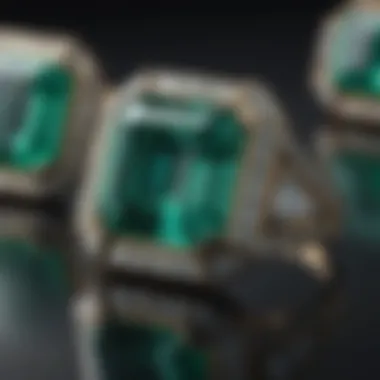
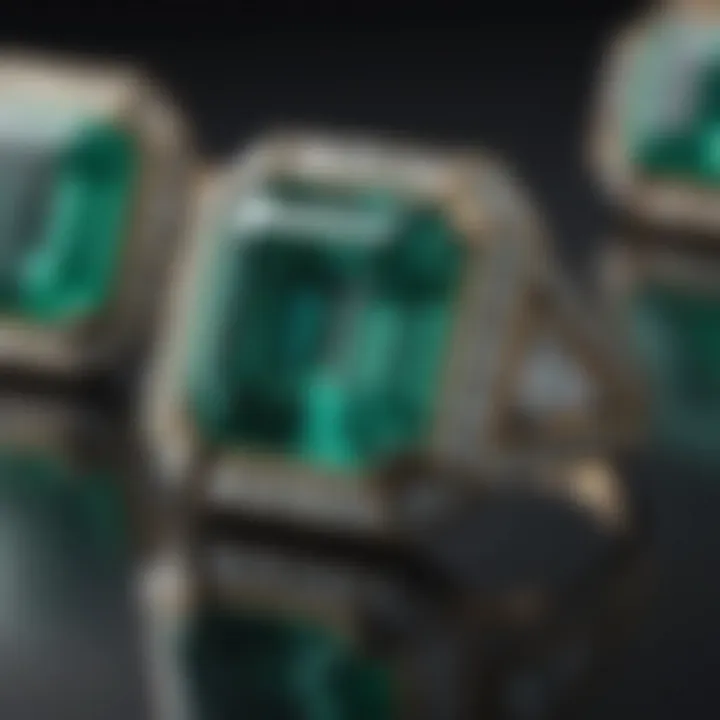
Influential Designers Using Emerald Cuts
The journey of emerald cuts in modern jewelry is, in many ways, sculpted by designers who have taken it upon themselves to revitalize this gem shape. Notable names come to mind, including names like Vera Wang, known for her exquisite flair, and Neil Lane, whose creations often dazzle celebrities.
These designers have:
- Innovated Techniques: By experimenting with innovative settings and combinations that showcase emerald cuts in striking new lights.
- Personalized Stories: Their pieces often tell a personal story. A ring isn't just jewelry; it's a significant emblem of commitment and love.
- Sustainable Sourcing: Many embrace ethical practices, ensuring that their emerald cuts are sourced responsibly, resonating with the values of modern consumers.
Emerald cuts, in the hands of visionary designers, blossom into statements of identity and artistry.
The Cultural Resurgence of Emerald Cuts
The renewed fascination with emerald cuts reflects a broader resurgence of classic aesthetics in contemporary culture. Over the years, there has been a shift toward valuing not just the visual appeal of jewelry but also the deeper meanings and cultural resonances that accompany specific cuts like the emerald cut. As society navigates through feelings of nostalgia and appreciation for craftsmanship, emerald cuts find themselves at the forefront of many discussions surrounding luxury, authenticity, and significance. This section will unpack various facets of this cultural phenomenon, shedding light on the essential elements and benefits of the emerald cut in modern contexts.
Symbolism and Meaning Associated with Emerald Cuts
Emerald cuts are not just a style choice; they also carry profound symbolism. Traditionally, emeralds have been associated with rebirth, fertility, and the promise of new beginnings. The cut's rectangular shape signifies clarity of thought and dignity. Wearing jewelry featuring an emerald cut can convey a sense of self-confidence and elegance.
Beyond their aesthetics, emerald cuts encapsulate the essence of craftsmanship and meticulous artistry. They represent a balance between beauty and practicality, embodying the philosophy that form should always follow function. This historical weight and artistic mastery impart a timeless charm, resonating deeply with gemstone enthusiasts and collectors.
"In every emerald cut lies a story of patience, precision, and the quest for perfection."
Emerald Cuts in Literature and Art
Literature and art play a pivotal role in elevating the emerald cut's status. The cut's geometric precision has inspired various artistic expressions, often symbolizing purity and virtue. For instance, writers have likened the clarity of an emerald cut to the clarity of thought achieved through introspection and contemplation.
Visual artists, too, have immortalized the emerald cut in their works. Impressionist and post-impressionist painters often incorporate gemstone imagery, using shapes reminiscent of the emerald cut to evoke feelings of depth and complexity within their compositions. Well-known works have depicted jewelry adorned with emerald cuts, highlighting their cultural significance and connection to themes of wealth, love, and aspiration. This not only reiterates the connection between jewelry and emotional storytelling but also showcases the emerald cut's lasting impact on creativity.
Emerald Cuts and Their Place in Pop Culture
In modern pop culture, emerald cuts are experiencing a revival sparked by celebrities and influencers. High-profile engagements featuring emerald cut rings have set trends across the globe, making them a popular choice for those seeking something that stands out yet remains elegant. The cut's versatility allows it to be paired with various styles, from vintage to contemporary, making it a favorite among designers and fashionistas alike.
Moreover, shows that delve into luxury lifestyles often highlight emerald cut jewelry, cementing it as a staple in high society. Social media platforms allow enthusiasts to showcase unique ways to style emerald cuts, broadening their appeal to a younger audience eager for distinctive pieces.
Overall, the emerald cut's presence in contemporary culture is more than just a fleeting trend. It signifies a deeper appreciation for things of quality and tradition in an era often dominated by mass production. As new generations come to appreciate the intricate craftsmanship and symbolic depth behind emerald cuts, their resurgence seems both inevitable and enriching.
Caring for Emerald Cut Gemstones
Caring for emerald cut gemstones is crucial for maintaining their allure and longevity. Unlike simpler cuts, emerald cuts feature step-like facets that are more vulnerable to scratches and chips. Their distinctive nature demands a vigilant approach to cleaning and maintenance. Delving into this subject not only enhances the gemstone’s visual appeal but also extends its life. Understanding the nuances of care can transform a piece of jewelry from merely beautiful to breathtakingly radiant.
Proper Cleaning Techniques
Emerald cuts require special handling when it comes to cleaning. Here are some effective techniques:
- Gentle solutions: Use a mild soap mixed with warm water. Avoid harsh chemicals that could dull the gem's brilliance.
- Soft tools: A soft-bristled brush can help remove dirt without risking scratches. Avoid abrasive materials that can mar the surface.
- Rinse thoroughly: After cleaning, rinse the stone in lukewarm water to remove any soap residue. Ensure it’s completely dry before storing.
- Count your time: A quick clean every few weeks keeps the stone sparkling, while deeper, less frequent cleaning will prevent buildup of grime.
Regular care is not just about aesthetics; it can significantly enhance the stone's durability.
Avoiding Common Mistakes in Care
Taking care of emerald cut gemstones means avoiding some common pitfalls that can lead to damage:
- Don't expose to heat: Heat can cause thermal shock to the stone, leading to fractures. Store your emerald cut jewelry away from direct sunlight and heat sources.
- Skip ultrasonic cleaners: Many people believe ultrasonic cleaning is a safe bet, but it can be risky for emerald cuts. Vibrations can create cracks, which can ruin the gem.
- Avoid contact with chemicals: Lotions, perfumes, and cleaning products can react negatively with the stone, causing it to lose its luster. Always apply these substances before putting on your jewelry.
Long-term Maintenance Tips
For long-lasting beauty, consider implementing these maintenance strategies for emerald cut gemstones:
- Regular checks: Have the stone examined periodically by a professional to ensure that settings remain secure and no damage has occurred.
- Store properly: When not worn, store emerald cut jewelry in a fabric-lined box away from other pieces to avoid scratching. Consider using individual pouches or compartments.
- Insurance valuation: As emerald cuts can be quite valuable, obtaining an appraisal and keeping a record can be wise for insurance purposes.
By incorporating these steps into your routine, you not only safeguard your emerald cut gemstones but also ensure they continue to captivate and enchant for generations.



